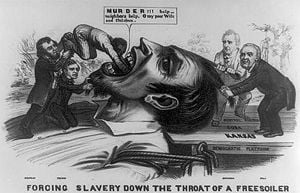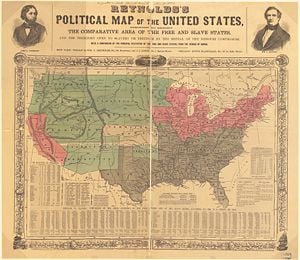Kansas-Nebraska Act
The Kansas-Nebraska Act of 1854 created the territories of Kansas and Nebraska and opened new lands for settlement, and allowed the settlers to decide whether or not to have slavery. The new Republican Party, formed in reaction against allowing slavery where it had been forbidden, emerged as the dominant force throughout the North. The act was designed by Democratic Senator Stephen A. Douglas of Illinois. While not repealing the Missouri Compromise of 1820, the new law did deem it "inoperative and void." The act established that settlers could decide for themselves whether to allow slavery, in the name of "popular sovereignty" or rule of the people. Opponents denounced the law as a concession to the Slave Power of the South. The act and the subsequent civil war known as Bleeding Kansas was a major and leading cause to the American Civil War.
Background
The availability of tens of millions of acres of excellent farm land made it necessary to create a territorial infrastructure to allow settlement. Railroad interests were especially eager to start operations since they needed farmers as customers. Four previous attempts to pass legislation had failed. The solution was a bill proposed in January 1854 by Senator Stephen A. Douglas of Illinois. He was the Democratic party leader in the United States Senate, the chairman of the Committee on Territories, an avid promoter of railroads, an aspirant to the presidency, and, above all, a fervent believer in popular sovereignty: the policy of letting the residents of a territory decide whether or not they would permit slavery to exist.
Douglas was very interested in having a railroad extend from his home city of Chicago to the West, reaching eventually to California. However, many southerners wanted a transcontinental railroad that would start in New Orleans and extend to southern California. Douglas decided to make a compromise with the southern senators. In exchange for having the railroad go through Chicago, he would introduce the Kansas-Nebraska Act in 1854. At first he proposed one new territory of Nebraska, then two of Kansas and Nebraska. Popular sovereignty would decide whether there would be slavery.
The Douglas bill caused a firestorm of opposition because it allowed slavery north of the line agreed upon in the Missouri Compromise, effectively repealing it. Even before the bill passed, a new grass roots opposition party was being organized in most northern states, the Republican Party. Northern Democrats, southerners, and President Franklin Pierce supported the bill. Douglas used brilliant parliamentary maneuvers to get the bill passed on May 30, 1854. It was signed into law by Pierce; he was a "doughface" or northerner whose political support came mostly from the South. There were now three political positions in American politics, represented by Northern Democrats (led by Douglas), the Northern Republicans, and the Southern Democrats. In 1860, they each ran a candidate for President of the United States.
Effects

An 1856 cartoon depicts a giant free soiler being held down by James Buchanan and Lewis Cass standing on the Democratic platform marked "Kansas," "Cuba" and "Central America." Franklin Pierce also holds down the giant's beard as Stephen A. Douglas shoves a black man down his throat.
The act divided the region into the Kansas Territory (south of the 40th parallel) and the Nebraska Territory (north of the 40th parallel). The most controversial provision was the stipulation that each territory would separately decide whether to allow slavery within its borders. This provision repealed the Missouri Compromise of 1820, which had prohibited slavery in any new states to be created north of latitude 36°30' since Kansas and Nebraska would be north of that line and could now choose to allow slavery.
Hostilities
Pro-slavery settlers rushed to Kansas mainly from Missouri. Their influence in territorial elections was often bolstered by resident Missourians who crossed the border into Kansas purely for the purpose of voting in such ballots. They were called border ruffians by their opponents, a term coined by Horace Greeley. John Brown and his sons helped in the fight against them and killed five pro-slavery farmers in the Pottawatomie Massacre. (John Brown also helped defend a few dozen free soil supporters from several hundred pro-slavery supporters at the town of Osawatomie.) Successive territorial governors, usually sympathetic to slavery, attempted unsuccessfully to maintain the peace. The territorial capital of Lecompton, Kansas, the target of much agitation, consequently became such a hostile environment for free-soilers that they set up their own unofficial legislature at Topeka.
The hostility reached during the debate over what would become the Kansas Nebraska Act turned brutally violent on the floor of the United States Senate. Senator Charles Sumner a Radical Republican and staunch abolitionist from Massachusetts was savagely beaten with a walking stick by South Carolina Congressman Preston Brooks. Sumner had railed against against Brooks' cousin, South Carolina Senator Andrew Butler ending a two day speech before the Senate, declaring Butler's position as "the crime against Kansas." The same day, May 21, 1856 a mob of pro-slavery settlers rode into the free soil town of Lawrence, Kansas and razed it, killing two of the townspeople. Outraged over the debate, Brooks' apparent rationale for the beating was instigated by the scathing attack against his cousin. Finding Sumner alone in the senate chamber the next day, Brooks stood over him and said, "I have read your speech twice over, carefully. It is a libel on South Carolina and on Senator Butler who is a relative of mine." Brooks then proceeded to use his walking stick to beat Sumner's head repeatedly. When the stick broke, Brooks continued to use the splintered end of the cane until he was restrained by other senators, who had been talking in a nearby cloakroom. Three years passed before Sumner was able to recover and return to the Senate.[1]
The hostilities between the factions reached a state of low-intensity civil war which was extremely embarrassing to Pierce, especially as the nascent Republican Party sought to capitalize on the scandal of Bleeding Kansas. The routine ballot-rigging and intimidation practiced by pro-slavery settlers failed to deter the immigration of anti-slavery settlers who won a demographic victory by winning the race to populate the state.
Constitution
The pro-slavery territorial legislature ultimately proposed a state constitution for approval by referendum. The constitution was offered in two alternative forms, neither of which made slavery illegal. Free soil settlers boycotted the legislature's referendum and organized their own which approved a free state constitution. The results of the competing referendums were sent to Washington by the territorial governor.
President James Buchanan sent the Lecompton Constitution to Congress for approval. The Senate approved the admission of Kansas as a state under the Lecompton Constitution, despite the opposition of Senator Douglas, who believed that the Kansas referendum on the Constitution, by failing to offer the alternative of prohibiting slavery, was unfair. The measure was subsequently blocked in the United States House of Representatives, where northern congressmen refused to admit Kansas as a slave state. Senator James Hammond of South Carolina (famous for his "King Cotton" speech) characterized this resolution as the expulsion of the state, asking, "If Kansas is driven out of the Union for being a slave state, can any Southern state remain within it with honor?"
Results
The Kansas-Nebraska Act split the nation and pointed it toward civil war. The act itself virtually nullified the Missouri Compromise of 1820 and the Compromise of 1850. The turmoil over the act split both the Democratic and Know Nothing Party and gave rise to the Republican party that soon controlled most of the Northern states.
Eventually a new anti-slavery constitution was drawn up. On January 29, 1861, Kansas was admitted to the Union as a free state. Nebraska was admitted to the Union as a state after the American Civil War in 1867.
Notes
- ↑ Flato Charles, The Civil War, Golden Press; New York. Page 23 – 25. ASIN: B000MKARLK
ReferencesISBN links support NWE through referral fees
- Bannerman, Mark. Railroaded! Leicester: Linford 2003. ISBN 9780708994818
- Etcheson, Nicole.Bleeding Kansas: contested liberty in the Civil War era. Lawrence: University Press of Kansas 2004. ISBN 9780700612871
- Holt, Michael F. The fate of their country: politicians, slavery extension, and the coming of the Civil War. New York: Hill and Wang 2004. ISBN 9780809095186
- Morrison, Michael A. Slavery and the American West: the eclipse of manifest destiny and the coming of the Civil War. Chapel Hill: University of North Carolina Press 1997. ISBN 9780807823194
- Rawley, James A. Race & politics: "bleeding Kansas" and the coming of the Civil War. Lincoln: University of Nebraska Press 1979. ISBN 9780803238541
External links
- The Kansas-Nebraska Act and the “Kansas Question" Retrieved April 17, 2007.
- Kansas-Nebraska Act Retrieved April 17, 2007.
- Nebraska—A Poem, Personal and Political Retrieved April 17, 2007.
Credits
New World Encyclopedia writers and editors rewrote and completed the Wikipedia article in accordance with New World Encyclopedia standards. This article abides by terms of the Creative Commons CC-by-sa 3.0 License (CC-by-sa), which may be used and disseminated with proper attribution. Credit is due under the terms of this license that can reference both the New World Encyclopedia contributors and the selfless volunteer contributors of the Wikimedia Foundation. To cite this article click here for a list of acceptable citing formats.The history of earlier contributions by wikipedians is accessible to researchers here:
The history of this article since it was imported to New World Encyclopedia:
Note: Some restrictions may apply to use of individual images which are separately licensed.
- REDIRECT Kansas Nebraska Act
